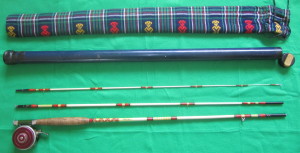My Grandfather’s glass fly rod
As I continue my reminiscing I will copy here essays about my life in academia, on the stream or in the woods. Several written a few years ago when I took the Academy for Lifelong Living class on writing your memoir. Others are new stories and reflect what I am thinking and doing now or adventures taken since the class. Today I chose one written about a fly rod I was given by my grandfather toward the end of his life, in fact he may have been about the age I currently enjoy. Here is that story:
Grandfather Anderson’s fly rod
4 August 2011
In my collection of fly rods is a white, fiberglass, Shakespeare fly rod that belonged to my Grandfather Anderson. This rod is 8 ft. long and quite stiff. I have fished with it on a few occasions but have always come away very arm weary. I wonder what kind of stories that rod would tell about its life and how it was handled?
Grandfather Anderson lived all of his life in Iowa (1876 to 1971), most of that in the very small town of Woodbine on the bluffs above the Missouri River in the western part of the state. Did Grandfather take the rod to that lake to fish for bass? For bluegills? Or northern pike? Was he a careful fly caster, able to place a popper or bass bug just so? What kind of jolt was transferred to Grandfather’s hand and arm when a bass or pike hit the lure?
I am tempted to speak for this rod, but won’t do so. I have fished with it on rivers in Oregon and Colorado, most recently in the 1980s on the Laramie River on the Hohnholz ranch in northern Colorado. The Hohnholz ranch is a 100 year ranch and the last one on the Laramie River where it leaves Colorado and enters Wyoming. This particular rod is a bit heavy, actually more than a bit, for fishing for trout in a stream like the Laramie. It is stiff and heavy and made to cast (throw?) a weight forward line. I have used a double taper line on it, perhaps a bit light weight for this rod. What I remember is that weight and how tired my arm became.
The fish that I caught in those days were mostly small trout, eight to twelve inches; the flies that I used were relatively large, 10s and 12s. The rod did its job well and gave me many hours of pleasure along the rivers – as I am sure it did for Grandfather.
When I received this rod it had been well used and the wrappings at the ferrules and guides were worn and beginning to come loose, the varnish was gone and the threads unraveling. I kept the rod put away and finally in the 1970s I took it out and re-wrapped it, using a fancy wrap – red, white and blue. At the butt just ahead of the handle I put on a diamond wrap, I replaced wraps all the way along the rod – at the ferrule, the guides and spacing in between. Looking at it today, I see that the finishing varnish has yellowed once again.
The rod came with an automatic reel – as you pull line off the reel to cast a spring in the top/bottom of the reel is wound tighter. A lever at the front of the reel which can be squeezed by a small finger to retrieve the line. The mechanism is really quite strong and would not work to retrieve a fish, when I fished with the rod I used a hand retrieve and the automatic to put the slack line back on the reel.
As I wrote this piece I looked up the rod on the web – it is a model 1380B FHL. The B means it was made for bass, Shakespeare also made a 1380T that was made for trout fishing. The FHL indicates the year and month in which the rod was made: 53, November(reference: fiberglass fly rods/Shakespeare). These rods were built by Shakespeare between 1951 and 1959. According the web site above, Shakespeare was first to market a fiberglass fly rod, putting the first ones out in 1947.
I keep this rod as a reminder of my early days on the stream and to keep me in touch with my grandfather’s fishing days and the joy he got from being on lake and stream. When I am there with this rod or with another I honor and remember his life and joy at being out doors.

